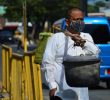San Pedro Cathedral priest, Fr. Gary Glenn Yba explains the traditions of Via Crucis, Siete Palabras, Sugat, and their meanings, among others, observed by the Roman Catholic Church in the Lenten season.
By CHERYLL D. FIEL
Davao Today
DAVAO CITY, Philippines — The world has just been treated to an elaborate rite of the Roman Catholic Church in the selection of the Pope held recently in Vatican.
The secrecy of the conclave and the emission of the white smoke that signified the selection of a new Pope enthralled the world with wonder.
Now as Lenten is observed, the Roman Catholic Church, replete with rites and symbolisms, invites its faithful more to its time-honored Lenten traditions, the Church’s way of celebrating the so-called “Paschal Mystery,” or the death and resurrection of Jesus Christ.
Davao Today interviewed San Pedro Cathedral’s Father Gary Glenn Yba about these practices, and what are they supposed to mean.
Lenten Season, he said “is a time to repent, reflect on the suffering and sacrifices of Jesus Christ and most of all to remember the love of a God who is just waiting for his people to ask for forgiveness. It is one way to purify ourselves to reach our inclination to be holy.”
Among the traditions of the Catholic Church observed during Lent are the following:
Ash Wednesday: It is the beginning of the Lenten Season. During Ash Wednesday, the ashes of the palms blessed on the previous Palm Sunday are imposed on the foreheads of the faithful, as a reminder “to repent, believe in the Gospel and remember that one is from dust and will return to dust.”
Palm Sunday. Catholics on this day bring palms to the Church to reenact the hailing of Christ’s entry to Jerusalem. The palms are blessed to begin the mass. The act, Fr. Yba explained, is supposed to be a celebration of Christ’s triumph, “that although he knew he will suffer and die on the cross upon entering Jerusalem, he accepted it, defeated fears, anxieties, and accepted the suffering for his love of God the father.”
Holy Monday and Holy Tuesday are best to be observed doing recollections.
Holy Wednesday should be a day for confession.
Holy Thursday. The Chrism Mass, Mass of the Lord’s Supper, Bisita Iglesia and Adoracion Nocturna are observed this day.
Chrism Mass. Fr. Yba explained that the Chrism Mass is the renewal of priests’ ordination. Chrism The mass at San Pedro Cathedral will start at 7:30 am.
The Chrism Mass is said to be “one of the principal expressions of the fullness of the Bishop’s priesthood and signifies the close unity of the priests with him.”
During this mass here the Bishops celebrate with the priests of the diocese, the Bishop consecrates the Chrism and blesses the holy oils.
According to the Ordo, the annual calendar of the Catholic Church, containing instructions for the Mass, the newly blessed holy oils are brought to the individual parishes. The old oils, are accordingly, burned, or may be put into the lamp which burn before the reserved Blessed Sacrament.
The Mass of the Lord’s Supper is a commemoration of Jesus Christ’s last supper with his disciples before he was turned over to death.
Activities at the mass include the washing of feet by the Bishop of twelve people who will symbolize the 12 apostles.
Fr. Yba explained that the act is to show the humility of Christ, and that “through the priests as instrumentalities, Christ still continues to do it.”
After the Mass of the Lord’s Supper, the Blessed Sacrament is then transferred to its place of repose.
According to the Ordo, it is not allowed to expose the Blessed Sacrament in a monstrance (the vessel in which the consecrated Host is exposed for the adoration of the faithful) or even in a ciborium (a goblet-shaped vessel for holding hosts). It is not also allowed to repose the Blessed Sacrament outside the Church. This rite is called the “Transfer of the Blessed Sacrament and Adoration.”
When this is done, the altar is stripped privately, and any crosses inside the church are covered with red or purple veil. Lamps, according to the Ordo, are not lit before the images of saints at this time.
At this time, the faithful are encouraged to adore the Blessed Sacrament for a suitable period of time during the night.
This Eucharistic adoration is also referred to as “Bisita Iglesia.” In tradition, the faithful usually choose seven churches with which to visit and pray before the Blessed Sacrament.
The Mass of the Lord’s Supper at the San Pedro Cathedral will start at 5:00 pm.
Good Friday. Among the rites observed on this day are the Via Crucis (Stations of the Cross), Siete Palabras(Seven Last Words), and the Procession of the Sto. Entierro (Procession of the Interred Christ).
The Via Crucis is done with the faithful offering a prayer for each station of the cross. The first station marks Jesus’ condemnation to death; the second, where Jesus carries His cross; third, where Jesus falls the first time; fourth, where Jesus meets his mother; fifth where Simon of the Cyrene helps Jesus to carry his cross; sixth, where Veronica wipes the face of Jesus; seventh, were Jesus falls the second time; eighth where Jesus meets the women of Jerusalem; ninth, where Jesus falls a third time; tenth, where Jesus’s clothes are taken away; 11th, where Jesus is nailed to the cross; 12th, where Jesus dies on the cross;13th, where the body of Jesus is taken down from the cross, and 14th, where Jesus is laid in the tomb.
The Via Crucis for the San Pedro Cathedral Parish will start at 4:30 am from Bolton Bridge.
Confessions at the San Pedro Cathedral will also start at 9:00 AM on this day, and by 12 noon, the Seven Last Words will start. Priests are assigned to give a homily for every word.
This ends at 3:00 PM where the Liturgy of the Word begins. The Liturgy of the Word, according to the Ordo, consists of three parts, namely, the Liturgy of the Word, the Adoration of the Cross and Holy Communion.
According to Fr. Yba, no signing of the cross is made from this hour on, and no songs are sung and no musical instruments are played in the Church, signifying Christ’s death at this moment.
Paschal Fast is accordingly observed from this day to honor the suffering and death of Christ and “to prepare the faithful to share more deeply in Christ’s resurrection.”
“Learning to say no to worldly happiness,” is the key, Fr. Yba said. The Church, according to Fr. Yba, encourages fasting and abstinence, a way to cleanse one’s self from sins, abstain from committing sins, and go through “internal conversion.”
Holy Saturday. The Church does not celebrate Holy Mass on this day until nightfall, or 6:00 in the afternoon, the Easter Vigil.
The entire celebration of this vigil, according to the Ordo, begins at nightfall and ends before dawn on Sunday. The Easter Vigil in the Holy Night will be at the Centennial Park, fronting the San Pedro Church.
Easter Sunday. The celebration of the resurrection of Jesus Christ.
A procession from Bolton will start at 4:00 AM, and Dawn Mass, also called “Salubong,”
“Encuentro” or “Sugat” will be at 4:30 AM at the Centennial Park.
The Sugat is said to be celebrated with the statues of the Risen Christ and Our Lady meeting and greeting each other, then through procession, both are brought inside the church where the Easter song and the Gloria are sung.
Father Yba invites the faithful to observe the Catholic traditions with the Church, as he said, it is a “nice experience” and a means to “remind faithful again of Christ offering his life, a way of showing gratitude to Christ who became human and suffered to redeem his people.” (Cheryll D. Fiel,davaotoday.com)










